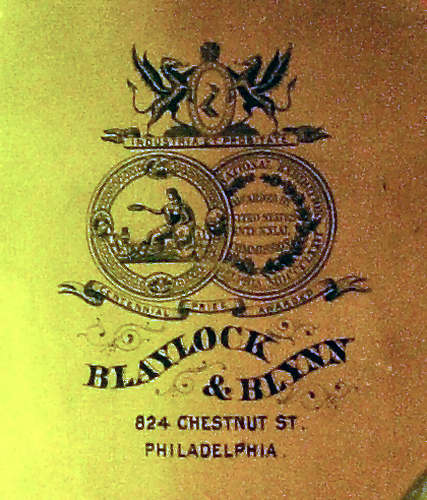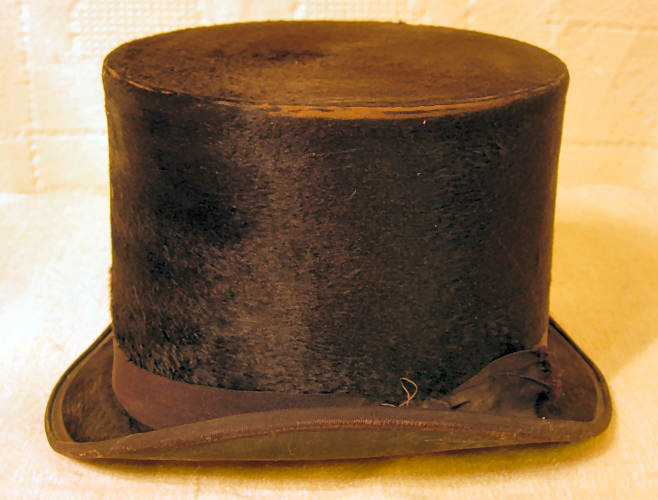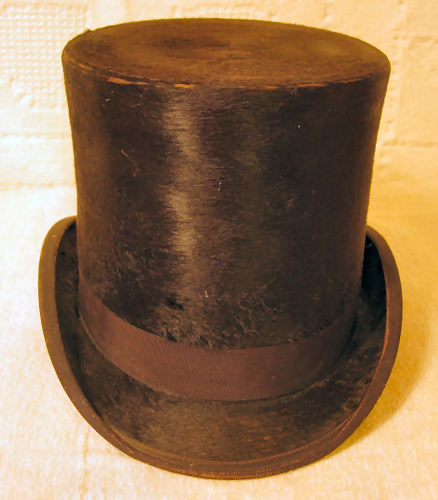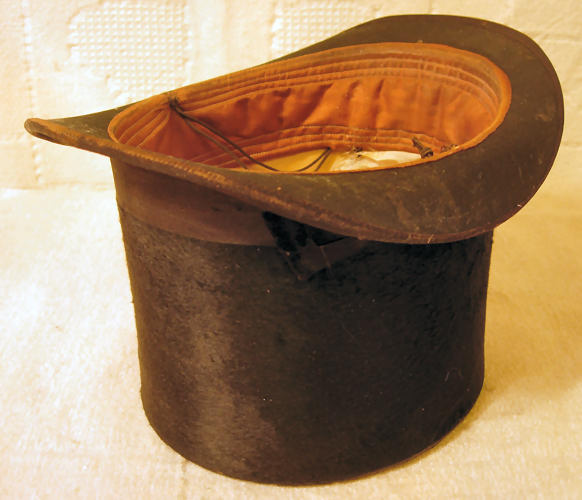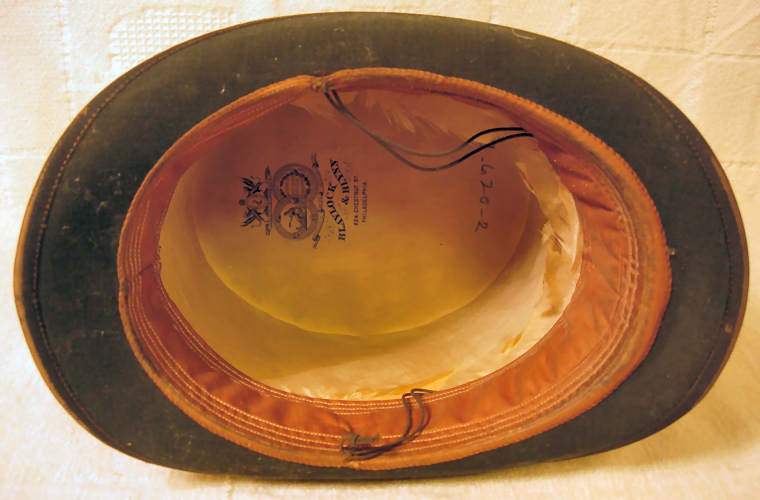

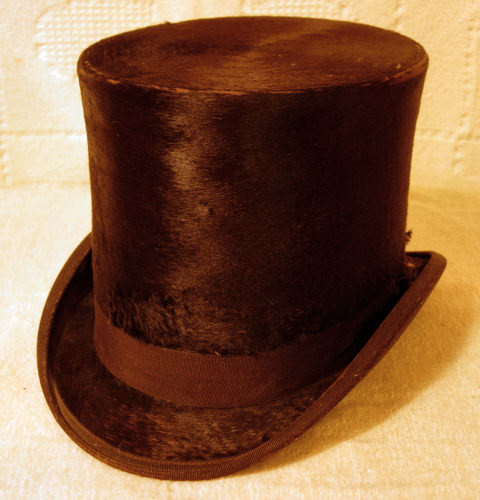
| This "silk" top hat dates from the 1870s to the early 1900s. The name silk top hat is a generally accepted name for the type of men's headgear more correctly called a top hat, but variously called a high hat, cylinder hat, chimneypot hat or stovepipe hat. The earliest reference to the top hat, per se, comes from the 1790s. But men's hats were popular much earlier than that. During the Colonial period, men's hats took the form of the tri-corn, or three-cornered hat. The tri-corn was simply a variation of the standard farmer's hat used to shield his eyes from the sun. The three-cornered hat consisted of a somewhat low, round crown surrounded by a wide brim, which was gathered against the crown and held in place by 'blocking' or shaping it over a wooden block form. By the 1790s, the top hat became popular. Instead of a low, round crown, the top hat took the form of a cylinder with a flat top. A flat brim, smaller than that of the tri-corn, was lifted up slightly on either side, but not on the front or back. The height of the cylindrical shaped crown varied over the years, sometimes, as in the case of the 'stovepipe' hat, reaching absurdly tall dimensions. The first top hats, like the tri-corn, were originally made of felt, derived most often from the soft under fur of beaver pelts. Felt for hats were also made from sheep wool or the fur from other mammals such as otters, muskrats and rabbits. The longer 'guard' hairs were pulled out of the pelt and discarded. Then the soft under fur, called the muffoon, was scraped off the pelt with a sharp knife. The loose fur was placed in a pile on a table, and the hatter then pulled and released the string of his stang (a special bow fitted with a sheep-gut string) so that the string smacked the pile of fur. As this process was repeated, the individual hairs of the fur began to stick together because of their scaly structure. The vibration of the process of smacking the loose fur with the stang also caused the individual hairs to crisscross each other in a random fashion that contributed to their sticking together. The somewhat flattened pile of loose fur was then flattened even more (into what was called a batt) by the hatter using a type of basket made of wooden slats. The batts, which were roughly triangular in shape with each side measuring about three feet, were then placed on a pile, separated from one another by a wet sheet of linen. Absorbing the moisture from the linen sheets, the batts became more solidified. A hatter would then take a pair of batts with the linen sheets in place, and knead and form them into a conical shape. The resulting cone shaped piece of felt was called a hood. The hoods would be placed into a kettle of boiling water and allowed to boil for between six and eight hours. In the process of boiling (also known as fulling), the hoods would shrink, binding the fibers together even tighter. The hoods were then dipped into the battery, which was a large kettle in which a mild acid was kept boiling. This caused the hoods to become even more solidified, and when removed from the acid bath, ready to be blocked and shaped. The shaping was done by placing the still hot, soaking wet hood over a wooden form, either low and round for tri-corn hats, or cylindrical and flat-topped for top hats, and then striking or rubbing it repeatedly with a small wooden club until it conformed to the shape of the wooden block. After the crown was satisfactorily blocked into shape, the brim would be flattened and smoothed using a wooden tool called a tolliker. The hat would then be placed in a warm oven to dry overnight. The next morning, excess material would be trimmed off the edge of the brim with a knife, and the brim would be rubbed with a pumice stone. The brim's edge would be turned over on itself to give a smooth, finished look. The entire surface of the hat would be ironed and then brushed with a fuller's brush to raise the nap. High points would be cut off with a fuller's shears, and then a final brushing was done to make sure that all of the individual hairs were lying in the same direction. The finisher completed the process by sewing a leather or satin sweatband to the inside edge and a silk ribbon to the outside, around the crown where it met the brim. Many of the early hats were left in their natural (fur) color, but when it became fashionable in the 1820s and 30s for top hats to be black, they would be dyed prior to the addition of the sweatband and ribbons. Around the year 1830 silk fibers began to be used in addition to, or in place of, the beaver fur. Initially a fur/felt hat would be produced and then its surface covered with a coating of shellac, onto which silk plush would be sprinkled. Later on, as the beaver fur became less and less available, the hat's structure was made from calico. The use of beaver fur in hat making eventually died out around the 1860s. The silk fibers, or plush, that were used in hat making were produced by a special type of machine up until the 1970s. It might be noted that the fumes from the acid in the battery, around which the hatters worked, would sometimes lead to mental instability ~ hence the phrase: Mad as a Hatter. |
